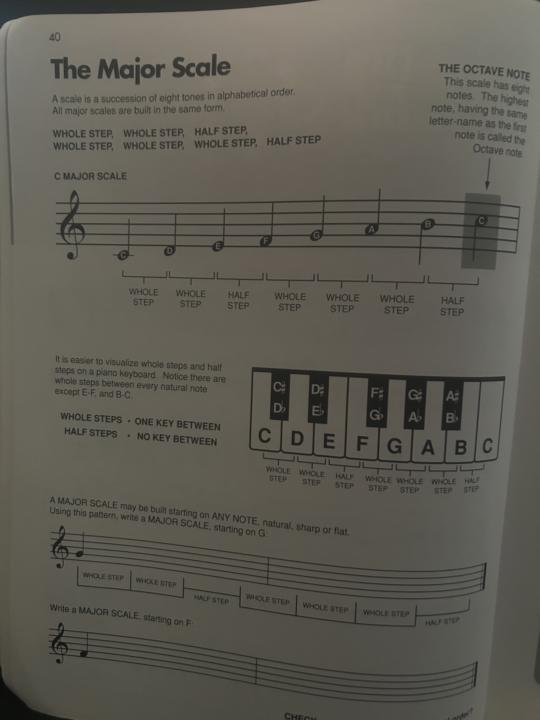Music Theory Monday
Do you know the formula for the Major Scale… without understanding this, the keys I was talking about may not make much sense?! Questions?!
1
0

Day 4 – The Key of A: From Classic Rock to Country Vibes
🎸 Day 4 – The Key of A: From Classic Rock to Country Vibes🎸 Welcome to Day 4 of the Learn to Play in All 12 Keys Challenge! Today we’re diving into the key of A — a powerhouse key for rock, pop, and country guitarists alike. You’ll learn: 🎵 The A major scale (open position + how it connects through CAGED) 🎵 Essential chords: A, D, E, F#m, and Bm 🎵 How to blend major and minor pentatonic sounds to create that pro-level feel 🔥 Songs for today: - Wild Thing – The Troggs (Classic I–IV–V in A) - Back in Black – AC/DC (Rock riff rooted in A major/minor pentatonic) - What’s Up? – 4 Non Blondes (A–Bm—D–A progression) - Wagon Wheel – Old Crow Medicine Show / Darius Rucker (Folk-country in A major) I vi IV V 🎯 Challenge: Pick one of today’s songs, or jam over an A–D–E progression. Record your progress and post it below — let’s keep rocking through all 12 keys! ⚡️ Video to come soon!
1
0

🎸 Day 3: Key of D – Expanding Your Chord Vocabulary
Today we’re exploring the Key of D, and adding some beautiful new sounds to your rhythm playing. We’ll be working on: ✅ The D major scale pentatonic and diatonic (open position and 2nd position). ✅ New minor chords: F#m, and Bm ✅ Chords including D, Em, G, and A, A7 Songs to jam along with: - Bad Moon Rising – CCR - Thinking Out Loud – Ed Sheeran - Breakfast at Tiffany’s – Deep Blue Something 👉 Watch the full lesson on YouTube (link below), play through the examples, and share your progress clip in the comments! Every day you show up, your fingers get stronger, your rhythm gets tighter, and your confidence grows. Let’s keep it rolling! Video dropped #UnleashYourInnerGuitarHero #14DayChallenge #Day3 #KeyOfD #GuitarPractice
Day 1 of the 7 day Challenge (unedited)
Originally, when I started planning this I thought: "I've got the whole weekend to prepare..." but then the weekend was crazy busy with church, soccer, going to the lake (it's been unseasonably warm in NY)... anyway... Here is day 1 unedited... Until then, enjoy! Here's the write up to prepare you for it: 🎸 Day 1 – The Key of C Major 🎸 Welcome to Day 1 of the “Play in All 12 Keys in 7 Days” Challenge! Today we’re starting with the foundation key — C major.No sharps, no flats — just pure music. You’ll learn: ✅ The C major scale in first position ✅ The core chords: C, Dm, Em, F, G, Am, Bdim (triad) ✅ Two classic songs to tie it all together:🎶 Lean on Me – Bill Withers🎶 Like a Rolling Stone – Bob Dylan and more... Practice tip:Play the C major scale slowly, say the note names out loud, and listen to how it connects to each chord. 🎥 Watch today’s lesson video here 👇(then post your practice clip or takeaway in the comments!) *coming soon*
🎶 Day 22 – The Magic of I–vi–IV–V Progressions
--- 🧩 Unleash Your Inner Guitar Hero Challenge – Week 3, Day 2 Yesterday, we tackled I–IV–V — today, we’re leveling up to a classic four-chord progression that shaped generations of music: I–vi–IV–V --- 🎯 Why This Progression? * It’s one of the **most emotional, melodic, and catchy** chord progressions ever. * Used in *everything* from Elvis to Green Day, Journey to Justin Bieber. * Once you recognize it, you’ll hear it **everywhere** — and you’ll be able to play a ton of songs instantly. ✅ Your Challenge: 1. Choose **2–3 keys** (start with C, G, D). 2. Identify the **I–vi–IV–V** chords in each. 3. **Play the chord progression** and listen for the emotional impact. 4. Drop a video or comment with: 🎸 What key you played 🎧 A song you recognize that uses it 🧠 Example (Key of C): * I = C * vi = Am * IV = F * V = G 🎵 Songs that use it: - “Stand By Me” – Ben E. King - “Every Breath You Take” – The Police - “Unchained Melody” – The Righteous Brothers - “Let It Be” – The Beatles (slightly varied but close) - “No Woman, No Cry” – Bob Marley - "Perfect" - Ed Sheeran - "Wonderwall" - Oasis @Eric Smith you've worked on some songs recently that have this chord progression, do you remember what they were?! Can you think of any other songs that use this progression? Ed Sheeran often says in video, that this is the chord progression that is in every pop song... What do you think? Comment below👇 **Bonus** For more advanced application: can you play the arpeggios from this progression in different keys, and/ or create sweep guitar patterns for them...?! @Rylan Lacroix - 🔁 Quick Reference Chart: | Key | I | vi | IV | V | | C | C | Am | F | G | | G | G | Em | C | D | | D | D | Bm | G | A | | A | A | F#m | D | E | | E | E | C#m | A | B | | F | F | Dm | Bb | C | 🎤 Bonus: Can you sing or hum a melody over this progression? Try making your own version — this progression is songwriting gold.
1-30 of 116
powered by

skool.com/unleash-your-inner-guitar-hero-9928
Unleash Your Inner Guitar with step by step instruction from Beginner to Advanced. Learn Songs Quickly From The Beginning with Great Technique!
Suggested communities
Powered by

